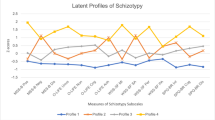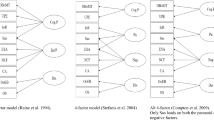Abstract
The Wisconsin Schizotypy Scales are widely used for assessing schizotypy in nonclinical and clinical samples. However, they were developed using classical test theory (CTT) and have not had their psychometric properties examined with more sophisticated measurement models. The present study employed item response theory (IRT) as well as traditional CTT to examine psychometric properties of four of the schizotypy scales on the item and scale level, using a large sample of undergraduate students (n = 6,137). In addition, we investigated differential item functioning (DIF) for sex and ethnicity. The analyses revealed many strengths of the four scales, but some items had low discrimination values and many items had high DIF. The results offer useful guidance for applied users and for future development of these scales.
Similar content being viewed by others
References
American Educational Research Association, American Psychological Association, & National Council on Measurement in Education. (1999). Standards for educational and psychological testing. Washington: AERA.
Barrantes-Vidal, N., Lewandowski, K. E., & Kwapil, T. R. (2010). Psychopathology, social adjustment and personality correlates of schizotypy clusters in a large nonclinical sample. Schizophrenia Research, 122, 219–225.
Barrantes-Vidal, N., Ros-Morente, A., & Kwapil, T. R. (2009). An examination of neuroticism as a moderating factor in the association of positive and negative schizotypy with psychopathology in a nonclinical sample. Schizophrenia Research, 115, 303–309.
Chapman, L. J., Chapman, J. P., Kwapil, T. R., Eckblad, M., & Zinser, M. C. (1994). Putatively psychosis-prone subjects 10 years later. Journal of Abnormal Psychology, 103, 171–183.
Chapman, L. J., Chapman, J. P., & Raulin, M. L. (1976). Scales for physical and social Anhedonia. Journal of Abnormal Psychology, 85, 374–382.
Chapman, L. J., Chapman, J. P., & Raulin, M. L. (1978). Body image aberration in schizophrenia. Journal of Abnormal Psychology, 87, 399–407.
Chmielewski, P. M., Fernandes, L. O. L., Yee, C. M., & Miller, G. A. (1995). Ethnicity and gender in scales of psychosis proneness and mood disorders. Journal of Abnormal Psychology, 104, 464–470.
Claridge, G., McCreery, C., Mason, O., Bentall, R., Boyle, G., Slade, P., et al. (1996). The factor structure of “schizotypal” traits: a large replication study. British Journal of Clinical Psychology, 35, 103–115.
DeVellis, R. F. (2012). Scale development: Theory and applications (3rd ed.). Los Angeles: Sage.
Eckblad, M., & Chapman, L. J. (1983). Magical Ideation as an indicator of schizotypy. Journal of Consulting and Clinical Psychology, 51, 215–225.
Eckblad, M., Chapman, L. J., Chapman, J. P., & Mishlove, M. (1982). The revised social Anhedonia scale. Unpublished test (copies available from T. R. Kwapil, Department of Psychology, University of North Carolina at Greensboro, P.O. Box 26170 Greensboro, NC 27402–6170).
Gooding, D. C., Tallent, K. A., & Matts, C. W. (2005). Clinical status of at-risk individuals 5 years later: further validation of the psychometric high-risk strategy. Journal of Abnormal Psychology, 114, 170–175.
Gooding, D. C., Tallent, K. A., & Matts, C. W. (2007). Rates of avoidant, schizotypal, schizoid and paranoid personality disorders in psychometric high-risk groups at 5-year follow-up. Schizophrenia Research, 94, 373–374.
Graves, R. E., & Weinstein, S. (2004). A rasch analysis of three of the Wisconsin scales of psychosis proneness: measurement of schizotypy. Journal of Applied Measurement, 5, 160–171.
Jackson, D. N. (1970). A sequential system for personality scale development. In C. D. Spielberger (Ed.), Current topics in clinical and community psychology (Vol. 2, pp. 61–96). San Diego: Academic.
Kaczorowski, J. A., Barrantes-Vidal, N., & Kwapil, T. R. (2009). Neurological soft signs in psychometrically identified schizotypy. Schizophrenia Research, 115, 293–302.
Kwapil, T. R. (1998). Social Anhedonia as a predictor of the development of schizophrenia-spectrum disorders. Journal of Abnormal Psychology, 107, 558–565.
Kwapil, T. R., Barrantes-Vidal, N., & Silvia, P. J. (2008). The dimensional structure of the Wisconsin Schizotypy Scales: factor identification and construct validity. Schizophrenia Bulletin, 34, 444–457.
Kwapil, T. R., Crump, R. A., & Pickup, D. R. (2002). Assessment of psychosis proneness in African-American college students. Journal of Clinical Psychology, 58, 1601–1614.
Mason, O., Claridge, G., & Jackson, M. (1995). New scales for the assessment of schizotypy. Personality and Individual Differences, 18, 7–13.
Meehl, P. E. (1990). Toward an integrated theory of schizotaxia, schizotypy, and schizophrenia. Journal of Personality Disorders, 4, 1–99.
Raine, A. (1991). The SPQ: a scale for the assessment of schizotypal personality based on DSM-III-R criteria. Schizophrenia Bulletin, 17, 555–564.
Reise, S. P. (1990). A comparison of item-and person-fit methods of assessing model-data fit in IRT. Applied Psychological Measurement, 14, 127–137.
Roussos, L. A., & Stout, W. F. (1996). Simulation studies of the effects of small sample size and studied item parameters on SIBTEST and Mantel-Haenszel type I error performances. Journal of Educational Measurement, 33, 215–230.
Silvia, P. J., & Kwapil, T. R. (2010). Aberrant asociality: How individual differences in social Anhedonia illuminate the need to belong. Journal of Personality. doi:10.1111/j.1467-6494.2010.00702.x
Stout, W., & Roussos, L. (1999). Dimensionality-based DIF/DBF package [Computer program]. Champaign-Urbana: William Stout Institute for Measurement, University of Illinois.
Winterstein, B. P., Willse, J. T., Kwapil, T. R., & Silvia, P. J. (2010). Assessment of score dependability of the Wisconsin Schizotypy Scales using generalizability analysis. Journal of Psychopathology and Behavioral Assessment, 32, 575–585.
Zimowski, M., Muraki, E., Mislevy, R. J., & Bock, R. D. (2003). BILOG-MG 3: Item analysis and test scoring with binary logistic models. Chicago: Scientific Software International.
Author information
Authors and Affiliations
Corresponding author
Additional information
The items for the Wisconsin Schizotypy Scales are available from Thomas R. Kwapil.
Rights and permissions
About this article
Cite this article
Winterstein, B.P., Ackerman, T.A., Silvia, P.J. et al. Psychometric Properties of the Wisconsin Schizotypy Scales in an Undergraduate Sample: Classical Test Theory, Item Response Theory, and Differential Item Functioning. J Psychopathol Behav Assess 33, 480–490 (2011). https://doi.org/10.1007/s10862-011-9242-9
Published:
Issue Date:
DOI: https://doi.org/10.1007/s10862-011-9242-9




